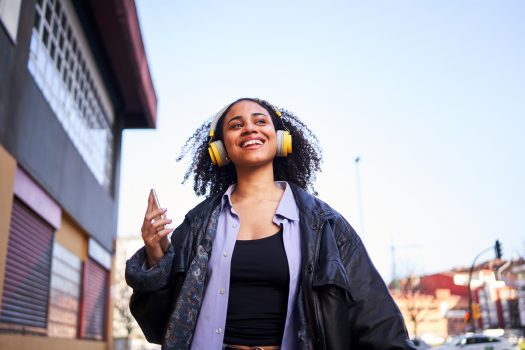Digital Audio Advertising: A Vital Component of Your Next Multi-Channel Marketing Strategy
by on 21st Sep 2023 in News

In association with Audacia
The world of audio is changing, and the possibilities for advertisers in the space are growing. In this article, Kym Treasure, founder & CEO of Audacia Audio, delves into the significance of digital audio advertising in today's dynamic marketing landscape.
For the first time streaming, on-demand audio has passed linear audio listenership. According to Edison research as of the end of Q2 2023, 50.3% of all daily audio time consumed by those in the U.S. age 13+ is now on on-demand platforms and 49.7% is on linear platforms. In 2023, there will be trillions of on-demand audio streams annually. While global markets will have varying shares, streaming audio has now become a fixture in the lives of many globally as they soundtrack their lives - be that relaxing, learning, commuting, working out, partying, or anything in between.

Though the above statistics should not point to traditional audio one day reaching zero and on demand being the only way people consume audio - it’s likely people will always have demand for some form of directed radio - this habit change is creating opportunities for marketers to engage audiences in moments and ways previously impossible. With numerous channels available to interact with target audiences, integrating digital audio advertising into a multi-channel marketing strategy is becoming increasingly indispensable. This can become all the more powerful when activated via programmatic technology - allowing for greater targeting control, flexibility and speed to market.
Audio advertising includes podcasts, radio, music streaming and even within gaming platforms. According to PwC’s Global Entertainment & Media Outlook digital audio is one of the fastest-growing advertising channels. In Asia Pacific, spending on audio advertising is expected to double between 2023-2025 from $2bn to $4bn annually. Marketers are increasing spend as consumers see this channel as trustworthy, informative, and local. Audio ads are also an excellent way to reach these consumers in screen-free moments, in an intimate and engaging setting.
How are Consumers Listening?
The jump in listening to digital audio streaming while in the car (or on public transportation) is noticeable across all age groups. It is now the most popular location to listen to podcasts among consumers 18-34 and 35-49. This is a great opportunity for brands to link their digital out of home (DOOH) and audio campaigns to target consumers on the go with sight and sound ? ?
Consumers are most likely to be listening at home during screen-less moments. For example - working, exercising, cooking, cleaning, sleeping or even meditating.
So, what are they listening to? There are over 5 million podcasts with over 70 million episodes between them as of 2023 according to Spotify. As podcasting popularity grows, co-listening is increasing. Specifically, teenage children (aged 13-17) listen with their parents most often during weekday mornings and on the weekends.
Comedy is the most popular podcast channel according to the latest Edison report from September 2023, followed by true crime, but due to the ease and speed of production, niches abound and micro-segments are constantly forming.
Audio as Part of a Multi-Channel Strategy
Despite the opportunity offered in audio, it would be remiss to suggest it should be the singular point in a marketing strategy, as all digital marketers already know. Audio can, however, play a starring role in a multi-channel strategy, enabling advertisers to reach consumers throughout the entire funnel.
The unique benefit of audio is that it gives advertisers the opportunities to reach audiences in environments outside of the home, and outside their typical devices, when they are on the move, during screenless moments.
By leveraging location targeting, we are able to pinpoint the most effective locations to target audiences on the move with audio. This could then be partnered with DOOH providers to sync these locations so that we can capture users through their ears and visually on the move.
Using audio as part of a multi-channel campaign helps to craft a brand story throughout the entire customer journey. By creating seamless coherence across the channels that a campaign appears on, advertisers can consistently remind audiences about their offerings, which will inch them closer to conversion as well as build brand awareness and personality.
On the topic of conversions and direct to consumer ads, podcasts offer a unique opportunity for brands to reach consumers through their favourite host using special codes and offers. This can be a specific URL to visit, a promo code to use at checkout, a phone number to call, or a unique landing page to access exclusive offers.
Brands can monitor website visits, coupon code usage, phone call volume, and other relevant metrics to assess the ROI (return on investment) of their podcast advertising campaigns.
It’s Time to Turn the Volume Up on Audio Advertising
Elevating advertising endeavours to new heights represents a top priority for companies within the ad tech sector, particularly in light of persistent challenges such as ad fatigue and dwindling audience attention.
A striking 42% of users have employed ad blockers in response to the inundation of advertisements that do not resonate with their cultural or value-based preferences. This holds significance because we are faced with an increasingly saturated and inundated advertising landscape with an abundance of video content with a lack of resonance. Audio, with the help of AI, can serve as an access to distinct media channels that enable precise segmentation, languages, and contextual targeting of advertisements, aligned with the content individuals are currently engaging with.
The audio industry is poised for a major expansion, thanks to the intersection of audio technology and artificial intelligence. Based on current trends, this convergence is expected to deliver unprecedented efficiencies for brands wanting to incorporate audio ads into their marketing campaigns at scale.








Follow ExchangeWire